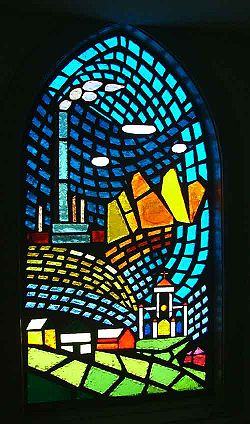
Anaconda Smelter Stack
Encyclopedia
The Anaconda Smelter Stack is a radial brick
smoke stack
, once part of the Anaconda Smelter at Anaconda, Montana
in the United States. The stack rests on a concrete foundation and measures 585 feet 1.5 inches high. The inside diameter of the stack is 75 ft (22.9 m) at the bottom and 60 ft (18.3 m) at the top. The wall thickness ranges from six feet at the bottom to two feet at the top.
Construction of the stack was completed on May 5, 1919. The Stack was built by the Alphons Custodis Chimney Construction Company of New York. At the time it was built, it was the tallest masonry
, brickwork
structure and chimney of any kind in the world and it remains the world's tallest and possibly largest free standing masonry structure. An interesting note is that the Washington Monument
would easily fit inside. It is commonly referred to as 'The Stack' and is a well known landmark in western Montana.
The stack was designed to discharge exhaust gases from the various roasting and smelting furnaces at the smelter. The stack is situated on the top of a hill. The smelter had a large network of exhaust flues from the furnaces that all fed a main flue. The main flue carried the combined smelter exhaust gases a half-mile up the hill to the stack. The flue system and stack combined to provide a natural draft to carry the smelter exhaust gases, and it was claimed to be capable of handling three to four million cubic feet per minute of gas.
The Anaconda Smelter was demolished after its closure in 1981, and the site underwent environmental cleanup. The stack alone, however, remains standing. After the smelter’s closure, citizens of Anaconda organized to “Save the Stack,” and in 1986 it was designated a state park. The site is known as Anaconda Smoke Stack State Park.

Brick
A brick is a block of ceramic material used in masonry construction, usually laid using various kinds of mortar. It has been regarded as one of the longest lasting and strongest building materials used throughout history.-History:...
smoke stack
Chimney
A chimney is a structure for venting hot flue gases or smoke from a boiler, stove, furnace or fireplace to the outside atmosphere. Chimneys are typically vertical, or as near as possible to vertical, to ensure that the gases flow smoothly, drawing air into the combustion in what is known as the...
, once part of the Anaconda Smelter at Anaconda, Montana
Anaconda, Montana
Anaconda, county seat of Anaconda City/Deer Lodge County, is located in mountainous southwestern Montana. The Continental Divide passes within 8 miles of the community with the local Pintler Mountain range reaching 10,379 feet...
in the United States. The stack rests on a concrete foundation and measures 585 feet 1.5 inches high. The inside diameter of the stack is 75 ft (22.9 m) at the bottom and 60 ft (18.3 m) at the top. The wall thickness ranges from six feet at the bottom to two feet at the top.
Construction of the stack was completed on May 5, 1919. The Stack was built by the Alphons Custodis Chimney Construction Company of New York. At the time it was built, it was the tallest masonry
Masonry
Masonry is the building of structures from individual units laid in and bound together by mortar; the term masonry can also refer to the units themselves. The common materials of masonry construction are brick, stone, marble, granite, travertine, limestone; concrete block, glass block, stucco, and...
, brickwork
Brickwork
Brickwork is masonry produced by a bricklayer, using bricks and mortar to build up brick structures such as walls. Brickwork is also used to finish corners, door, and window openings, etc...
structure and chimney of any kind in the world and it remains the world's tallest and possibly largest free standing masonry structure. An interesting note is that the Washington Monument
Washington Monument
The Washington Monument is an obelisk near the west end of the National Mall in Washington, D.C., built to commemorate the first U.S. president, General George Washington...
would easily fit inside. It is commonly referred to as 'The Stack' and is a well known landmark in western Montana.
The stack was designed to discharge exhaust gases from the various roasting and smelting furnaces at the smelter. The stack is situated on the top of a hill. The smelter had a large network of exhaust flues from the furnaces that all fed a main flue. The main flue carried the combined smelter exhaust gases a half-mile up the hill to the stack. The flue system and stack combined to provide a natural draft to carry the smelter exhaust gases, and it was claimed to be capable of handling three to four million cubic feet per minute of gas.
The Anaconda Smelter was demolished after its closure in 1981, and the site underwent environmental cleanup. The stack alone, however, remains standing. After the smelter’s closure, citizens of Anaconda organized to “Save the Stack,” and in 1986 it was designated a state park. The site is known as Anaconda Smoke Stack State Park.


